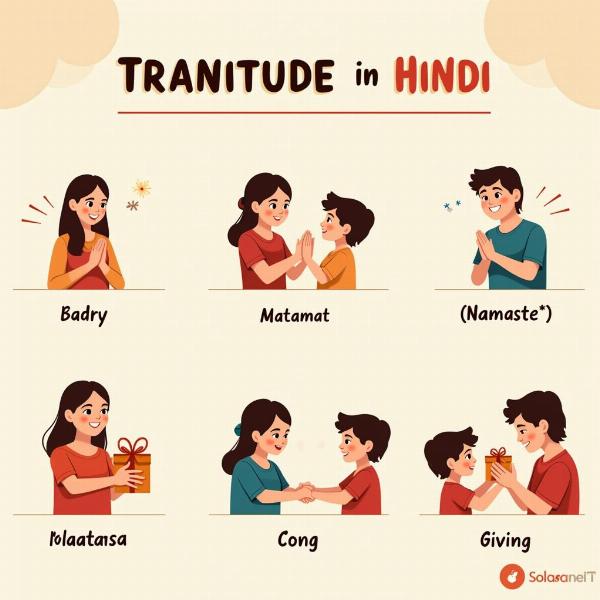Understanding how to express gratitude is crucial in any language, and Hindi, with its rich cultural nuances, offers a beautiful array of ways to say “thanks for it.” This article delves into the various ways to convey appreciation in Hindi, exploring both formal and informal expressions, cultural contexts, and the subtle art of conveying genuine gratitude. Whether you’re a beginner learning Hindi or simply curious about Indian culture, understanding “thanks for it meaning in Hindi” will enhance your communication and deepen your appreciation for the language.
Various Ways to Say “Thanks for It” in Hindi
Hindi offers a plethora of ways to express gratitude, each with its own subtle meaning and appropriate context. The most common and versatile equivalent of “thanks for it” is “इसके लिए धन्यवाद” (iske liye dhanyavaad). This phrase is suitable for most situations, both formal and informal. “धन्यवाद” (dhanyavaad) literally translates to “thank you,” and adding “इसके लिए” (iske liye), meaning “for this,” specifies the reason for your gratitude.
However, beyond this standard expression, Hindi allows for more nuanced expressions of gratitude. For instance, “शुक्रिया” (shukriya) is a more informal and heartfelt way to say “thank you,” often used among friends and family. You can also use “बहुत शुक्रिया” (bahut shukriya) to express profound gratitude, similar to “thank you very much.”
 Expressing Gratitude in Hindi
Expressing Gratitude in Hindi
Formal vs. Informal Expressions of Gratitude
Just as in English, the level of formality in Hindi influences the choice of words and expressions. In formal settings, such as business meetings or when addressing elders, “इसके लिए धन्यवाद” (iske liye dhanyavaad) is the most appropriate choice. You can also use “आपका बहुत-बहुत धन्यवाद” (aap ka bahut-bahut dhanyavaad), which translates to “thank you very much,” for expressing deeper gratitude in a formal setting.
In informal settings, you have more flexibility. “शुक्रिया” (shukriya) and “बहुत शुक्रिया” (bahut shukriya) are commonly used, creating a warmer and more personal tone. You can also add words like “यार” (yaar) or “दोस्त” (dost), meaning “friend,” to further personalize your expression of thanks among close friends.
Cultural Context and Nonverbal Cues
While verbal expressions are essential, understanding the cultural context surrounding gratitude in India adds another layer of meaning. Indians often accompany “thank you” with a slight bow or by joining their hands in a “Namaste” gesture. This nonverbal cue signifies respect and reinforces the expression of gratitude.
Beyond “Thanks For It”: Showing Deeper Appreciation
Sometimes, a simple “thank you” isn’t enough to express genuine appreciation. Hindi offers ways to convey deeper gratitude. For instance, you can say “मैं आपका बहुत आभारी हूँ” (main aapka bahut aabhari hoon), which translates to “I am very grateful to you.” This phrase expresses a more profound sense of appreciation.
Going the Extra Mile: Expressing Gratitude Through Actions
In India, actions often speak louder than words. Offering a small gift or extending a helping hand in return are common ways to show appreciation beyond verbal expressions. These actions demonstrate sincerity and strengthen the bond between individuals.
Conclusion: Mastering the Art of Gratitude in Hindi
Understanding “thanks for it meaning in Hindi” goes beyond simply learning the words. It involves grasping the cultural nuances, choosing the appropriate expressions for different contexts, and recognizing the power of nonverbal cues. By mastering these aspects, you can effectively communicate your gratitude and build stronger relationships with Hindi speakers. So, the next time you want to express appreciation, remember the richness and depth of the Hindi language and choose the expression that best conveys your sincere thanks.
FAQ
-
What is the most common way to say “thanks for it” in Hindi? The most common way is “इसके लिए धन्यवाद” (iske liye dhanyavaad).
-
How do I say “thank you very much” in Hindi? You can say “आपका बहुत-बहुत धन्यवाद” (aap ka bahut-bahut dhanyavaad) in formal settings or “बहुत शुक्रिया” (bahut shukriya) in informal situations.
-
What are some nonverbal cues associated with expressing gratitude in India? Joining hands in a “Namaste” gesture and a slight bow are common nonverbal cues.
-
How do I express deeper gratitude in Hindi? You can use phrases like “मैं आपका बहुत आभारी हूँ” (main aapka bahut aabhari hoon) to express deeper appreciation.
-
What are some ways to show gratitude beyond words in India? Offering a small gift or extending a helping hand are common ways to show appreciation through actions.
-
Is “shukriya” appropriate for formal settings? While acceptable in some informal professional settings, it’s generally better to use “dhanyavaad” in formal situations.
-
How do I pronounce “dhanyavaad” correctly? The pronunciation is approximately “dhun-yuh-vaad,” with the emphasis on the first syllable.
Meaning-Hindi.in is your one-stop solution for all your Hindi translation needs. We specialize in various translation services, including business and commercial document translation, certified and legal document translation, technical and user manual translation, website and localization translation, educational and academic document translation, express translation, and specialized translation. Need accurate and culturally sensitive translations? Contact us today at [email protected] or call us at +91 11-4502-7584. Meaning-Hindi.in is here to bridge the language gap for you.